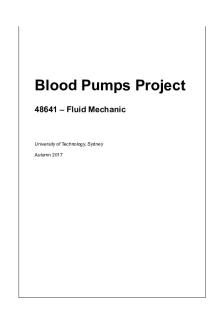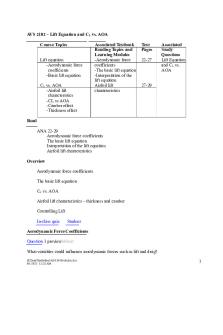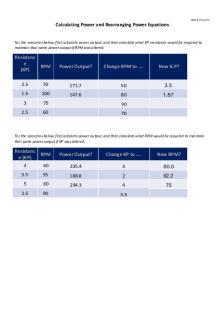Bernoulli Equation Pumps and Turbines PDF

| Title | Bernoulli Equation Pumps and Turbines |
|---|---|
| Author | Ahmed Deabs |
| Course | All MFG |
| Institution | جامعة القاهرة |
| Pages | 4 |
| File Size | 147.3 KB |
| File Type | |
| Total Downloads | 103 |
| Total Views | 168 |
Summary
Download Bernoulli Equation Pumps and Turbines PDF
Description
Be rnoulli Equa t ion : Pum ps a nd T urbine s When the original Bernoulli equation was derived we simplified the equation through the elimination of frictional loss and shaft work. Since that original derivation, we have introduced head losses through friction to the equation to consider the practical application of the equation to a working environment. Now we consider the inclusion of equipment which do shaft work on the fluid (i.e. pumps) or have work done by the fluid (i.e. turbines). Pu m ps There are different types of pumps such as reciprocating positive-displacement pumps, rotary positive displacement pumps, rotary gear pumps, centrifugal pumps, etc. These will be discussed in detail in later lessons. For now, we are primarily concerned with the pump head, hP – the pressure increase afforded the fluid as it passes through a pump. So the modified Bernoulli equation gain yet another term,
u1 2 2g
P1 g
z1
hP
P2 g
u2 2 2g
z2
fL u*2 D 2g
u*2 K 2 g
Within the hydraulic pump power, Po , equation, the pump head can be found:
Po F u P A u P Q hP g Q where P is the pressure rise across the pump The actually power used to drive a pump is larger than the hydraulic pump power due to losses from its mechanical operation. We typically regard this difference in terms of a pump efficiency, np. The pump efficiency is defined below and discussed in more detail in Chapter 24. nP
Po (hydraulic) Po (motor _ rating )
T urbine s The work done by the fluid on the turbine is considered an energy loss for the flow system. The turbine head loss, hT b will have a negative sign to the pump head and should be included with the other losses in the modified Bernoulli equation.
P1 g
2
u1 z1 g2
P2 g
2
u2 z2 g2
2
fL u* D g2
2
K
u* hTb g2
Ex a m ple 1. Consider a suction pump installed at the base of an embankment to draw water up to a house. A flow rate of 25 gpm of water is decided to be reasonable for the needs of the residence. A length 115 ft of 1 1/2-nominal schedule 80 PVC pipe was used along with a basket strainer, 2-45o elbows, 3-90o elbows and an exit fitting. The water is received in a holding tank.
4
30 ft
2 3
1
Solution: There are three instances of the Bernoulli equation to be solve in the problem:
P1 g
2
u1 2g
P2 g
P3 g
u2 2g
2
z2
2
u2 2g
2
u3 2g
2
P2 g
z1
z3
z2
P4 g
P3 g
hP 2
u4 2g
2
K
u* 2 g
K
u* 2 g
2
u3 2g
z3 2
z4
Collect the data we know: P1 = P4 = Patm z1 = 0, z4 = 30 ft D = 0.125 ft A = 0.01227 ft2 Q = 25 gpm = 0.0557 ft3 /s thus Water 3 Density, 1.94 slug/ft 1.9 x10 5lbf -s/ft2 Viscosity, We can calculate the Reynolds number, Re
fL u * D 2g
fL u * D 2g
2
u = 4.54 ft/s
1 .94 ( 4.54 )(0 .125 ) 1 .9x10 5
5 .8 x10
4
For PVC piping, it is permissible to assume the pipe is smooth and therefore, using the Reynolds number calculated in the Moody chart we get f =0.0205. Since the piping is the same throughout the system, we can simplify the three Bernoulli equations above into a single equation,
P1 g
2
u1 2g
z1
P4 g
hP
2
u4 2g
2
2
fL u* D 2g
z4
u K * 2 g
and with pressure and velocity head terms canceling out, we can further simplify: 2
hP
z4
z1
2
fL u * D 2g
u K * 2 g
Thus, 2
hP
30
0.0205(115) 4.54 0.125 2 32.2
2
1. 3 2(0.35) 3(1.4) 1.0
4.54 2 32.2
hP 38.34 ft Calculation of the hydraulic power,
Po
F u
P A u
P Q
hP g Q
Po
38 .34 1.94 32 .2 0.0557 , units [ft x
Po
0.242 HP
lb f
s ft
x ft/s2 x ft3 /s ]
2. A fire truck uses a river as a water source for a nearby raging fire. The water is pumped up through a long hose to a nozzle which is 100 ft above the surface of the river. The water exits the nozzle at 100 ft/s with a total flow rate of 500 gal/min. The hose has a hydraulic diameter equivalent to a 4” schedule 40 steel pipe and may be assumed to have the same relative roughness. The total length of the hose, considering the pump, fittings and valves, is 300 ft. What power is required by the truck’s pump? Solution: We chose the river surface to be point 1 and the nozzle of the hose to be point 2, so the problem is
P1 g
2
u1 2g
z1
hP
P2 g
2
u2 2g
2
z2
fL u* D 2 g
Since the problem has simplified the inclusive effects of the valves and fittings into the roughness of the hose alone, we can quickly calculate our friction head, 4” schedule 40 pipe,
O.D. 4.5”, I.D. 4.026”
Relative roughness =
0. 00015 = 4.47 x 10-4 0.3355
D2 =8.84 x 10-2 ft2 4 Avg. velocity = Q 1.12 / 0.0884= 12.67 ft/s (100 ft/s is only at the nozzle) A ft lb uD 62 .4 12 .67 0.3355 s ft ft3 Reynolds Number, Re = = lb f s ft 2 1.9 x10 5
Area of hose =
Re =
12 .67 0.3355 =4.3x105 9. 8x 10 6
Before we move on, please note that the two lines above do not match. If you look at the unit balance you will note that you have to convert between lbm and lbf . To do this, you need to use Newton’s second law: lb f 32 .2 lbm (this is instead of using 1.94 slug/ft3 ) The determined friction factor is: fL u 2 D 2g
f
0 .017. So now we can calculate the friction head loss.
0.017 300 12.67 2 0.3355 2 32 .2
ft ft 2 s 2 ft s2 ft
= 37.89
Note : In terms of potential energy, the vertical distance of 100 ft is important. However, for calculation of the frictional losses, the length L actually indicates the length of piping through which the water travels, i.e. 300 ft. The pressure at both points are the same and the velocity at point 1 can be considered negligible next to the velocity at the end of the nozzle at point 2, we can simplify the Bernoulli equation to: 2
z1 hP
u2 2g
hP 100
hP
z2
(100 )2 37 .89 2 32 .2 293.17 ft
0
Calculate the power from the pump head, Po Po Po
2
fL u * D 2 g
F u
P A u
293 .17 1.94 32 .2 1.12 [ft-lbf /s] 37 HP
P Q
hP g Q...
Similar Free PDFs

Modified Bernoulli Equation
- 14 Pages

Blood Pumps Project 1
- 37 Pages

Steam Turbines
- 433 Pages

Lift Equation And CaE
- 18 Pages

Bernoulli Experiment
- 4 Pages

Persamaan-bernoulli
- 27 Pages

Informe Bernoulli
- 6 Pages

Les turbines à gaz.HB
- 20 Pages

Control of Wind Turbines
- 19 Pages
Popular Institutions
- Tinajero National High School - Annex
- Politeknik Caltex Riau
- Yokohama City University
- SGT University
- University of Al-Qadisiyah
- Divine Word College of Vigan
- Techniek College Rotterdam
- Universidade de Santiago
- Universiti Teknologi MARA Cawangan Johor Kampus Pasir Gudang
- Poltekkes Kemenkes Yogyakarta
- Baguio City National High School
- Colegio san marcos
- preparatoria uno
- Centro de Bachillerato Tecnológico Industrial y de Servicios No. 107
- Dalian Maritime University
- Quang Trung Secondary School
- Colegio Tecnológico en Informática
- Corporación Regional de Educación Superior
- Grupo CEDVA
- Dar Al Uloom University
- Centro de Estudios Preuniversitarios de la Universidad Nacional de Ingeniería
- 上智大学
- Aakash International School, Nuna Majara
- San Felipe Neri Catholic School
- Kang Chiao International School - New Taipei City
- Misamis Occidental National High School
- Institución Educativa Escuela Normal Juan Ladrilleros
- Kolehiyo ng Pantukan
- Batanes State College
- Instituto Continental
- Sekolah Menengah Kejuruan Kesehatan Kaltara (Tarakan)
- Colegio de La Inmaculada Concepcion - Cebu






